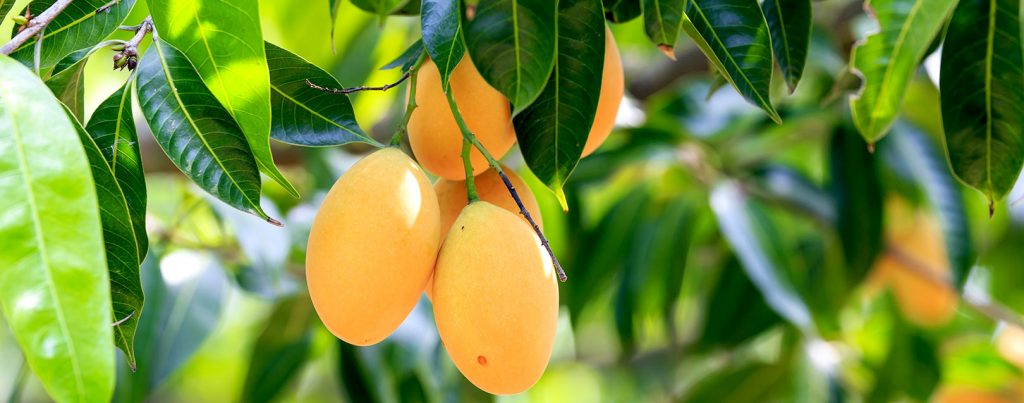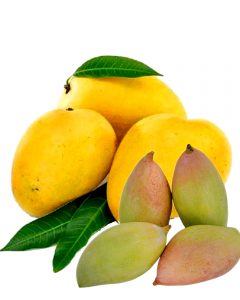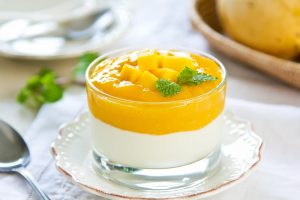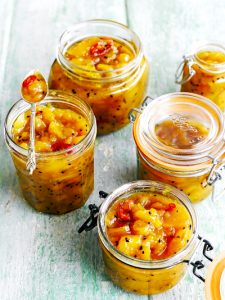It is May, which means one thing: The onset of mango season across India, and the usual debate on which variety is the best of them all. Read on for a brief history of this much-loved fruit, and the many ways it can be relished.

Few have resisted the appeal of the ‘King of Fruits’, which has been cultivated in India for over 4,000 years. The many warlords and conquerors who invaded India’s lands were smitten by mangoes. Alexander the Great took several varieties of the fruit with him when he returned to Greece. The Portuguese set about cultivating and improving the stock, whilst the Mughal emperors were famous for their obsessive love of mangoes. Babur was encouraged to create his Indian empire on introduction to the fruit; Humayun established a courier system to supply him with mangoes during his retreat to Kabul; and Akbar established an orchard where he grew 100,000 mango trees.
Shah Jahan had his own son, Aurangzeb, arrested for failing to supply him with mangoes from his favourite tree, and as emperor, Aurangzeb used mangoes as both currency and as a form of diplomacy, sending the fruit to Shah Abbas of Persia to support him in his fight for the throne. The fruit was a metaphor of power and prestige.
Kama, the god of love and lust, fires arrows made of five fragrant flowers, including the mango flower. The sensuous shape of the fruit means that it has long been associated with love and fertility. An ancient Sanskrit poet wrote: As the mango flowers begin to swell, to put forth sprouts,
to bud and finally to blossom, Love too swelled, sprouted, budded and blossomed.
The 1978 film Junoon (‘Intoxication’) plays on this association in a scene set in a mango grove where young women sing a song about rain and love. The mango season begins with spring flowers and ends during the monsoon season. The Urdu poet Mirza Ghalib proclaimed himself a connoisseur of mangoes, and his letters made many mentions of the fruit, praising different varieties, discussing problems with transportation, and thanking friends for sending them to him. He quipped ‘Mangoes need to have two qualities: They need to be sweet and there needs to be plenty’.
Bengali poet and writer Rabindranath Tagore wrote of the flower:
On this love of mine have traced their autographs
the pollen of the mango-blossom,
and the dew-cooled fragrance of the sephalika
the twitterings of the doels in early dawn
and the rapturous touch of the beloved.
The mango tree is sacred to Hindus, and the leaves are used to adorn the entrances to homes during festivals to signify good fortune. The Jain goddess Ambika sits beneath a mango tree, and the Buddha caused a mango tree to grow from seed in an instant at the sacred site of Shravasti. Buddhist monks took mangoes with them wherever they went, and mango trees were planted along India’s ancient highways as a symbol of prosperity. The shape of the fruit has long fascinated India’s craftsmen, and it is an iconic motif woven into shawls and saris and block-printed onto textiles.
Such is the love for the mango that dedicated festivals are held in many cities and heritage tours take place in Uttar Pradesh. The media is not far behind – the forthcoming season has already been analysed, as happens every year. The Indian Express noted in January that delayed flowering may affect the availability of crops in western India, but that there will be a possible glut in the market later in the summer. Andhra Pradesh’s Department of Horticulture released a statement the same month reassuring the public that they are monitoring problematic ‘climate conditions’, and Karnataka’s State Mango Development and Marketing Corporation told the media in February that good rainfall and increased good practice certification means they are anticipating expanding foreign exports of the fruit. The arrival of temporary street stalls and shops stocked with mangoes is celebrated in headlines such as ‘King of fruits makes its grand entry into markets’.
Regional Specialties
All said, the Indian public is very picky about mangoes. Shoppers feel the texture of the fruit, check the colour and smell the fragrance before buying. Each region has its own cultivars and favourite varieties that go into cooling drinks, sweet desserts and tangy pickles. It is the core ingredient in seasonal specialities, whether ripe or raw, and an intrinsic part of India’s gastronomic heritage. Many mangoes are just eaten fresh, sliced into segments by street vendors and quickly swallowed with the juices running down the fingers. Here is a guide to some of India’s different types of mango, and what they are used for.
 Western India: The sunshine yellow Alphonso mango is India’s most popular variety, the ‘king of mangoes’ and superior to all other fruits in its exotic scent, sweetness, richness and flavour. It is cultivated only in Maharashtra, and is available from mid-July. It is said to be named after the Portuguese explorer, Afonso de Albuquerque, who established trading colonies in Goa; the Portuguese settlers introduced the variety through grafting selected mango cultivars on existing rootstock. Medium in size, the Alphonso’s saffron-coloured flesh is firm, sweet, satiny and buttery with little fibre. This is the variety of mango that’s most widely exported.
Western India: The sunshine yellow Alphonso mango is India’s most popular variety, the ‘king of mangoes’ and superior to all other fruits in its exotic scent, sweetness, richness and flavour. It is cultivated only in Maharashtra, and is available from mid-July. It is said to be named after the Portuguese explorer, Afonso de Albuquerque, who established trading colonies in Goa; the Portuguese settlers introduced the variety through grafting selected mango cultivars on existing rootstock. Medium in size, the Alphonso’s saffron-coloured flesh is firm, sweet, satiny and buttery with little fibre. This is the variety of mango that’s most widely exported.
The foothills of Mount Girnar in Gujarat have given their name to the Gir Kesar mango, another variety with golden yellow skin. It is juicy and popular with cooks as, like the Alphonso, its flesh isn’t too fibrous. Kesar mangoes are available from May to July.
 Southern India: Andhra Pradesh is one of southern India’s most significant ‘mango belts’ and a supplier of high-quality fruit to its neighbouring states. Juicy, fibreless Banganapalli mangoes are large yellow fruits that have a sweet but slightly sour taste. They hail from the village of the same name in Andhra Pradesh and are available from May to July. They are also called Safeda mangoes. Neelam mangoes are a favourite in Hyderabad, particularly in the month of June when they are at their most abundant. Small in comparison to many other varieties, they have an orange skin and a distinctive floral fragrance.
Southern India: Andhra Pradesh is one of southern India’s most significant ‘mango belts’ and a supplier of high-quality fruit to its neighbouring states. Juicy, fibreless Banganapalli mangoes are large yellow fruits that have a sweet but slightly sour taste. They hail from the village of the same name in Andhra Pradesh and are available from May to July. They are also called Safeda mangoes. Neelam mangoes are a favourite in Hyderabad, particularly in the month of June when they are at their most abundant. Small in comparison to many other varieties, they have an orange skin and a distinctive floral fragrance.
The texture and taste of the Badami mango from Karnataka is similar to that of the Alphonso mango. It is widely grown and best eaten in May. The Rasapuri mango is oval-shaped, juicy, although fibrous, with excellent flavour. It is commonly used to make pulp. Greenish-yellow Totapuri mangoes are grown throughout Andhra Pradesh, Karnataka and Tamil Nadu, and are named for their distinct shape, which looks like the beak of a parrot. The flavour is unusual, tangy and piquant rather than sweet, and they are eaten dusted with salt and chilli powder or used in salads. For the most part, Totapuri mangoes are used to make chutneys, pickles and other processed mango products for export. It is probably the first variety to hit the markets during mango season.
The production area of Mulgoba mangoes is predominantly in Tamil Nadu, but the variety is also grown in the neighbouring parts of Andhra Pradesh and Karnataka. A fully ripe fruit is very large, and can weigh up to 1.5 kg. It is round and remains green when ripe – look for a pink
blush at the tip to indicate it is ready to eat. The flavour is rich, spicy and sweet. The Sindhura variety of mango, which is grown across southern India, has green and red skin, with a succulent fibrous pulp. It is also called ‘honey’ mango as it is so sweet, and consequently is used in making jam, jellies and preserves.

Northern India:The state of Uttar Pradesh produces many of northern India’s best mango varieties. Green Dussehri mangoes are intensely sweet and best enjoyed by tearing off the tip and sucking out the sweet pulp and juice. They are one of India’s older varieties, and were grown in the Nawab of Lucknow’s gardens in the 18th century. Mango groves exist all around the small town of Malihabad, 30 km from Lucknow, and 80 per cent of the country’s produce of this variety are grown here. Their season is brief, June to July. Chaunsa mangoes, also from Uttar Pradesh, are amongst the sweetest mangoes grown in northern India and said to have been named by the warrior emperor Sher Shah Suri after his victory over Humayun in the Battle of Chausa. They are golden yellow in colour, with a red blush, an exquisite aroma and fleshy, nectar-like pulp. Chaunsa mangoes are available in July and August.
Langra mangoes are medium in size, oval shape and a green colour even when ripe. The flesh is bright lemon-yellow, very juicy and without fibre. The variety is available May to August. It is believed to have originated in Varanasi and said to be named langra, meaning ‘lame’, after the name of the man who planted the mango seed in his garden. Although grown around the region, aficionados claim that only those grown on Varanasi land are authentic in taste.

Eastern India: The Himsagar mango season lasts just four weeks. A speciality of West Bengal and Orissa, the Himsagar mango has a thin green skin, smooth and creamy flesh and vivid fragrance. It is eaten raw or used in desserts and milk shakes.
Culinary Notes
Amrakhand
 Alphonso mangoes are best enjoyed eaten as they come, but the fruit is also pulped, then thickened with milk or cream, whilst Kesar mangoes are used to make ice cream, halwa and the frozen milk dessert kulfi. Aam ras is a popular dessert made in western India with the pulp of these varieties, mango nectar that is made by blending the peeled and chopped pieces of fruit with a pinch of cardamom powder and some saffron strands. It is chilled before serving and traditionally eaten with pooris, the puffed fried bread. Aam ras is served at weddings, sometimes as part of the thali meal. Amrakhand is a similar local dessert made with mangoes blended with thick homemade curd and chilled. Mangoes are preserved as chunda, a raw mango sweet pickle or marmalade made with turmeric and sugar and flavoured with chilli and cumin. Chunda is made in big batches to last the year. In earlier times it was made by laying out the grated mango in the heat of the sun to dissolve the sugar, but most cooks will now use quicker, stove-top recipes.
Alphonso mangoes are best enjoyed eaten as they come, but the fruit is also pulped, then thickened with milk or cream, whilst Kesar mangoes are used to make ice cream, halwa and the frozen milk dessert kulfi. Aam ras is a popular dessert made in western India with the pulp of these varieties, mango nectar that is made by blending the peeled and chopped pieces of fruit with a pinch of cardamom powder and some saffron strands. It is chilled before serving and traditionally eaten with pooris, the puffed fried bread. Aam ras is served at weddings, sometimes as part of the thali meal. Amrakhand is a similar local dessert made with mangoes blended with thick homemade curd and chilled. Mangoes are preserved as chunda, a raw mango sweet pickle or marmalade made with turmeric and sugar and flavoured with chilli and cumin. Chunda is made in big batches to last the year. In earlier times it was made by laying out the grated mango in the heat of the sun to dissolve the sugar, but most cooks will now use quicker, stove-top recipes.
Kairi Murg
 Hard, sour, unripe mangoes are the basis of southern India’s mouthwatering Avakkai pickles, one of the most common homemade condiments in homes. The mango is chopped with the skin in place, and left to dry naturally over a couple of days. The pieces are mixed with oil and a selection of spices, left to steep for several days, and then bottled in jars. Avakkai pickles accompany rice and plain dal. Mango Thokku is a tangy, spicy chutney made with grated sour mango, spices and jaggery cooked in sesame oil, cooled and bottled to be eaten with curd rice and paratha flatbread. Grated sour mango is mixed with cooked rice, pulses, cashew nuts and spices to create a savoury side dish. Centuries of Islamic influence have brought pungent, meaty curries to Hyderabad, where mangoes are incorporated into main dishes. Chopped, uncooked mango pieces are added to Kairi Murg, or Mango Chicken, at the final stage of cooking. Mango pulp flavours the lamb dish Amras ki Boti, and raw unripe mangoes are a main ingredient in Kairi ka do Pyaza, a green mango, lamb and onion curry.
Hard, sour, unripe mangoes are the basis of southern India’s mouthwatering Avakkai pickles, one of the most common homemade condiments in homes. The mango is chopped with the skin in place, and left to dry naturally over a couple of days. The pieces are mixed with oil and a selection of spices, left to steep for several days, and then bottled in jars. Avakkai pickles accompany rice and plain dal. Mango Thokku is a tangy, spicy chutney made with grated sour mango, spices and jaggery cooked in sesame oil, cooled and bottled to be eaten with curd rice and paratha flatbread. Grated sour mango is mixed with cooked rice, pulses, cashew nuts and spices to create a savoury side dish. Centuries of Islamic influence have brought pungent, meaty curries to Hyderabad, where mangoes are incorporated into main dishes. Chopped, uncooked mango pieces are added to Kairi Murg, or Mango Chicken, at the final stage of cooking. Mango pulp flavours the lamb dish Amras ki Boti, and raw unripe mangoes are a main ingredient in Kairi ka do Pyaza, a green mango, lamb and onion curry.
Shakaramba
 Northern India also has mango dishes that combine seasonal mangoes with Hindu and Muslim culinary influences. Shakaramba, or mangoes with semolina, is a Diwali specialty in Lucknow that mixes smooth, soft, fried semolina with mango pieces that have been sautéed in butter then cooked in sugar syrup. Chilled Panha, or raw mango cooler, is a delicious way of using mangoes before they have ripened fully. The chopped green mango is boiled in water, liquidised and then reheated with sugar, saffron and cardamom to make a concentrate. Stored in the fridge, a small amount diluted with chilled water is perfect for hot, muggy days.
Northern India also has mango dishes that combine seasonal mangoes with Hindu and Muslim culinary influences. Shakaramba, or mangoes with semolina, is a Diwali specialty in Lucknow that mixes smooth, soft, fried semolina with mango pieces that have been sautéed in butter then cooked in sugar syrup. Chilled Panha, or raw mango cooler, is a delicious way of using mangoes before they have ripened fully. The chopped green mango is boiled in water, liquidised and then reheated with sugar, saffron and cardamom to make a concentrate. Stored in the fridge, a small amount diluted with chilled water is perfect for hot, muggy days.
Kancha Aam er Chatni
 Bengali Green Mango or Kancha Aam er Chatni is the most widely cooked of West Bengal’s many chutney recipes, and is served as a palate-cleansing course with crispy papadums before dessert. The sliced mango is tempered with spices in hot oil, and then cooked gently in water before sugar is added and the heat raised to reduce the liquid. Kacha Aamer Tok Dal combines the flavour and goodness of mangoes with lentils in a tangy soup.
Bengali Green Mango or Kancha Aam er Chatni is the most widely cooked of West Bengal’s many chutney recipes, and is served as a palate-cleansing course with crispy papadums before dessert. The sliced mango is tempered with spices in hot oil, and then cooked gently in water before sugar is added and the heat raised to reduce the liquid. Kacha Aamer Tok Dal combines the flavour and goodness of mangoes with lentils in a tangy soup.
